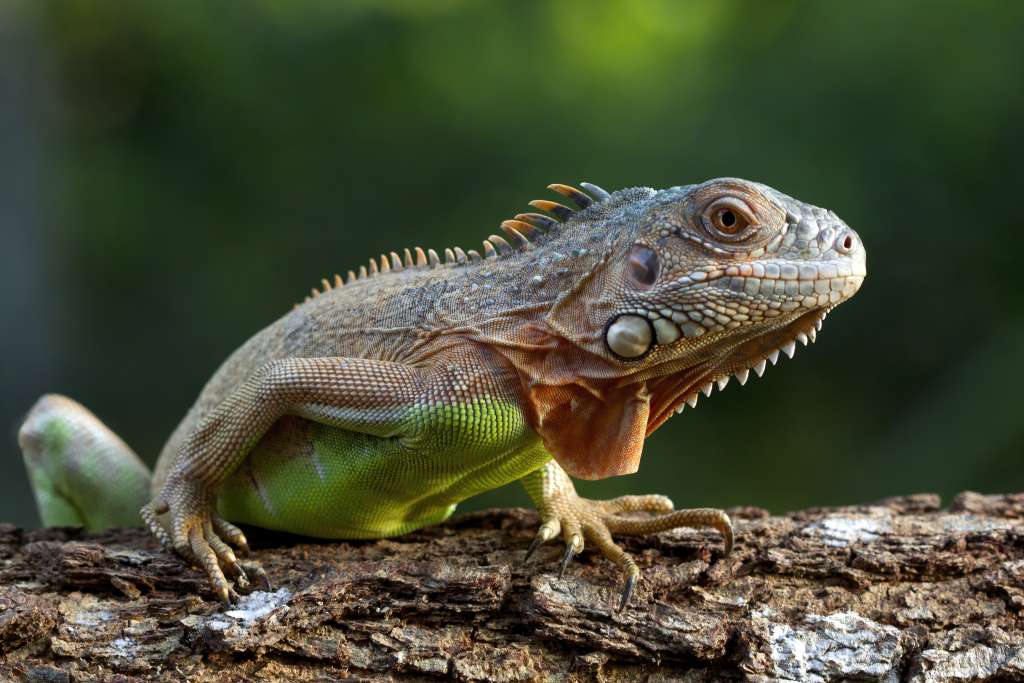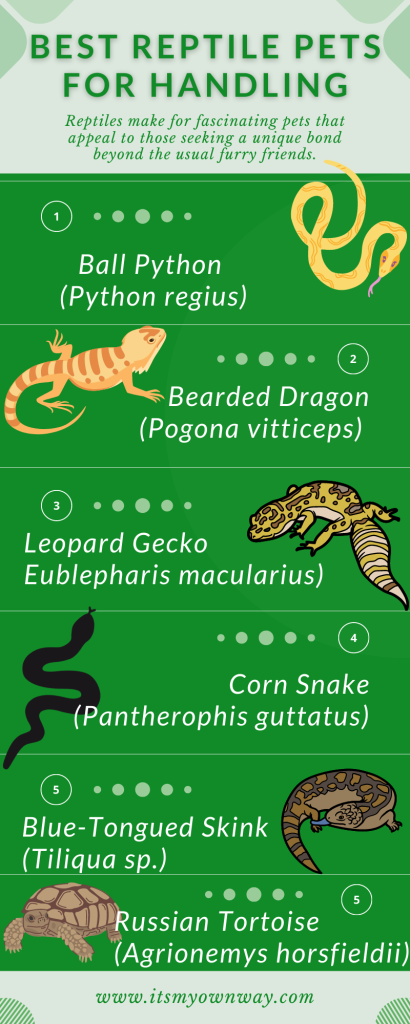Reptiles make for fascinating pets that appeal to those seeking a unique bond beyond the usual furry friends. As a result, herpetology has gained popularity among enthusiasts who enjoy interacting with their scaly companions. However, not all reptiles are suitable for regular human interaction. It is vital to explore and understand the best reptile pets for handling to ensure a positive experience for both pet and owner. In this article, we explore the temperament, ease of care, and overall suitability of various reptile species. Our comprehensive guide helps novices and experienced keepers make informed decisions. Whether you’re enchanted by the captivating gaze of a snake or charmed by the unique appeal of a lizard, this guide will assist you in finding the ideal pet reptile for a rewarding bond that transcends the ordinary.
The Appeal of Reptile Pets
Reptile pets are fascinating due to their exotic appearance, unique behaviors, and low-maintenance lifestyle, making them ideal for individuals with little time or limited living space. Compared to traditional pets, reptiles don’t require daily walks or a lot of socialization, saving you much effort. Additionally, reptile care can be more affordable than pet care, which makes them more appealing to budget-conscious owners. However, you should be careful when selecting a reptile because not all can handle them easily, and their temperament and stress levels may differ. Therefore, understanding the charm of reptiles is crucial if you desire to make a wise choice about which reptiles to get.
Factors to Consider Before Choosing a Handling Reptile

To ensure that your reptile pet receives adequate care and lives a healthy life, it is important to consider some factors before bringing them into your home. Among these factors are size, temperament, lifespan, diet, and specific care requirements. Additionally, it’s crucial to learn about local reptile-related rules and ordinances because some species could not be permitted in particular locales. You can establish a loving atmosphere for your new pet and have a wonderful handling experience with the right research and planning. Remember, taking care of a reptile is a serious commitment that necessitates adequate research and preparation to guarantee a successful and enjoyable ownership experience.
If you’re looking to keep a reptile as a pet, it’s important to choose a species that is well-suited for regular interaction with humans. Not all reptiles behave well in these situations, so it’s essential to select reptiles with calm dispositions, manageable size, and easy handling characteristics. Let’s take a look at some of the top reptile pets that are known for their suitability for handling based on their temperament and care needs. Overall, handling reptiles can be an exciting and fulfilling experience, but it’s crucial to choose the right species to ensure a positive and safe interaction.
1. Ball Python (Python regius)
The ball python, which is also known as the royal python, is a famous choice among reptile fans and is highly recommended for people who are new to the hobby of keeping snakes. These non-venomous constrictor snakes originated from West and Central Africa. Among snake species, they are relatively smaller in size and generally reach a length of 3 to 5 feet. They are well recognised for their kind disposition, and their deliberate movements make them simple to control. They are now among the most sought-after snakes to have as pets because of this.
Ball pythons are commonly recognized for their calm nature, which means they feel at ease when engaged with regularly. They generally have a high tolerance for being held and, if handled appropriately, seldom demonstrate any signs of hostility. Nevertheless, it is crucial to give them a secure and well-proportionate shelter with appropriate environmental circumstances, including regulation of temperature and humidity, to keep them healthy and stress-free.
2. Bearded Dragon (Pogona vitticeps)
Bearded dragons have become increasingly popular as pets due to their affectionate and engaging disposition. These diurnal lizards hail from the dry regions of Australia and boast a unique “beard” composed of spiky scales beneath their throat, which they use to communicate during a variety of behavioral interactions.
The peaceful and amiable temperament of bearded dragons makes them excellent pets. They are sociable and relaxed when being held by their owners. They are well-liked by reptile aficionados and come in many different colour varieties. Additionally, they are easy to take care of, making them a perfect choice for beginners and experienced reptile keepers alike.
3. Leopard Gecko (Eublepharis macularius)
Leopard geckos are small lizards that are active at night. They come from Pakistan, Afghanistan, and some regions of India’s stony deserts. These lizards have a mild disposition, are easy to take care of, and are small in size, which has contributed to their increased popularity as pets that can be handled.
The fact that leopard geckos are often tolerant and rarely feel stressed makes them one of the easiest reptiles to handle. They are well-known for their strikingly beautiful patterns and can regrow their tails. If you are looking for a visually captivating and low-maintenance pet, leopard geckos can be a perfect choice.
4. Corn Snake (Pantherophis guttatus)
Corn snakes, originating from North America, are a popular type of snake that can be easily kept as pets due to their gentle temperament, reasonable size, and attractive patterns. They have been bred in captivity for many years, resulting in a wide variety of colors and appearances to choose from.
Corn snakes are a popular choice for handling reptiles because of their friendly and curious temperament. They don’t require too much effort in caring for them and can be regularly handled without getting too overwhelmed. However, it’s important to approach them in a calm and confident manner when handling them, so as to make them feel comfortable and reduce the likelihood of accidental injuries, as with all snakes.
5. Blue-Tongued Skink (Tiliqua sp.)
Blue-tongued skinks, which are medium-sized lizards, are commonly found in Australia and some parts of Indonesia. These lizards are highly identifiable due to their vibrant blue tongues. They cleverly employ their blue tongues as a defence mechanism to frighten off would-be predators.
Blue-tongued skinks have a friendly and curious nature, which makes them great companions for experienced reptile lovers. They love exploring their surroundings and are comfortable with human interaction, provided that they are approached carefully. Nevertheless, they require a larger enclosure and specialized care compared to other reptiles; hence prospective owners must be prepared to meet their specific needs.
6. Russian Tortoise (Agrionemys horsfieldii)
If you are searching for a reptile that does not belong to the snake or lizard family, the Russian tortoise is an excellent option to consider. These small tortoises are originally from Central Asia and are perfect for handling due to their gentle nature and reasonable size.
Russian tortoises are known for their friendly nature and can tolerate handling well. However, they prefer solitary and independent behaviors compared to other reptiles. To keep them healthy, it is crucial to provide proper care and nutrition, including their specific dietary requirements, and access to natural sunlight or appropriate UV lighting.
Proper Handling Techniques
You can learn a lot and enjoy handling reptiles, which can lead to a stronger bond with your scaly friend. However, it’s crucial to handle them carefully and follow appropriate techniques for the benefit of both you and your reptile. Different species of reptiles have different behaviors and preferences, so it’s important to understand your pet’s specific needs. Here are some important techniques to remember in order to ensure proper handling.
1. Approach Calmly and Confidently:
To handle your reptile, it is crucial to approach them calmly and confidently. Abrupt movements or loud noises can surprise them and trigger stress or defensive reactions. First, extend your hand slowly towards the reptile to let them become familiar with your scent and presence before attempting to lift or handle them. This strategy can help establish trust and minimize any potential threats perceived by the reptile.
2. Support the Body Properly:
To prevent discomfort or stress, it is crucial to properly support the body of a reptile when picking it up. Snakes require support along their entire length to avoid bending or twisting. Lizards should be held gently and securely to prevent falls or jumping. Do not grab reptiles by their tails, as doing so can cause distress or injury.
3. Allow the Reptile to Explore:
Reptiles are naturally inquisitive beings who like discovering new places. When handling them, it’s ideal to let them move at their own pace while exploring your hands or arms. Avoid holding them in uncomfortable postures or forcing them to move. This helps them feel more relaxed and in charge, leading to a better overall handling experience.
4. Watch for Signs of Stress:
When handled, reptiles may exhibit stress-related behaviours such hissing, biting, or attempting to flee. In such cases, it is essential to stop handling them immediately and allow them to go back to their enclosure. Remember, every reptile reacts differently to stress, so it is necessary to observe their behavior and adjust handling sessions accordingly.
5. Wash Hands Before and After Handling:
Before handling any reptile, it is imperative to properly cleanse your hands with soap and water. It is well known that reptiles can contain dangerous parasites or germs that can impair human health. Regular hand washing contributes to both the owner’s and the pet’s safety and wellbeing. It’s also a good idea to wash your hands once more after handling to stop the spread of any potential germs.
6. Limit Handling Time:
Although handling can be enjoyed by both the reptile and the handler, it is crucial to limit the duration of the handling sessions. For reptiles, prolonged handling sessions can be stressful, especially if they are not used to regular human contact. The duration of the handling sessions should gradually increase over several sessions to enable the reptile to adjust to the experience.
7. Respect Their Boundaries:
It is important to remember that not all reptiles enjoy being handled or interacting with humans. Some species may prefer to be observed rather than touched. It’s important to respect the limitations and preferences of your reptile. If you notice that your pet consistently exhibits signs of stress or discomfort during handling, it may be best to limit handling and focus on providing an environment within their enclosure that is both stimulating and enriching.
When it comes to handling your reptile, it’s important that you use proper techniques and pay attention to your pet’s behavior and cues. By doing so, you can ensure that both you and your scaly companion have a positive and enjoyable experience. When handled gently and respectfully on a regular basis, you can improve your relationship with your reptile.
Creating a Suitable Habitat
In order to maintain the good health and happiness of your pet reptile, it is crucial to create a suitable living environment for them. This section will cover the important aspects of setting up their enclosure, such as providing the right substrate, maintaining optimal temperature and humidity levels, providing hiding spots, and including enriching objects. By designing a habitat that closely imitates their natural surroundings, you can enhance the well-being and comfort of your reptile. This, in turn, will make it more enjoyable for both you and your pet during handling sessions.
Owning a reptile as a pet has its share of inherent risks. It is important to handle these creatures with care, even if they seem docile, to avoid putting them in uncomfortable situations that may make them react defensively. To keep both yourself and your pet safe, it is important to be aware of the potential risks associated with handling reptiles and follow safety guidelines. By knowing how to handle your reptile safely and confidently, you can ensure a positive and harmonious bonding experience between you and your pet.
Frequently Asked Questions-
Are all reptiles suitable for handling?
Not all reptile species are ideal for handling. Some reptiles may be too aggressive, nervous, or delicate to tolerate regular human interaction. It’s essential to research the temperament and specific care needs of a reptile before considering them as a handling pet.
How often should I handle my reptile?
The frequency of how often you handle your pet reptile relies upon the species and the personality of the animal. For instance, some reptiles may enjoy being touched daily, whereas others might prefer less handling. To avoid making your pet stressed, it is essential to monitor their behavior and adjust the amount of handling accordingly.
Can children handle reptiles?
When dealing with reptiles, it’s important to approach them gently and responsibly. While some reptiles have a calm temperament that makes them suitable for interacting with kids, it’s crucial to supervise any interactions between the child and the reptile to ensure the safety of both parties.
Do reptiles bond with their handlers?
Reptiles don’t form bonds in the same way mammals do, but they can recognize their handlers and become accustomed to regular interaction. Over time, they may show signs of comfort and familiarity with their handlers.
What if my reptile shows signs of stress during handling?
If your reptile displays signs of stress, such as hissing, biting, or trying to escape, it’s essential to stop handling immediately and give the animal time to calm down in its enclosure. Some reptiles may need more time to acclimate to handling than others.
Conclusion: Finding Your Ideal Handling Reptile
Once you have examined the different types of reptiles that are suitable for handling, you may end up favoring one that is the most compatible with your lifestyle, experience, and preferences. It is necessary to thoroughly research the specific care requirements of your chosen reptile and be ready to provide them with long-term care for their well-being. By selecting the appropriate reptile pet and following correct handling and care practices, you can develop a fulfilling bond with your scaly companion that will bring you happiness and curiosity for many years.










